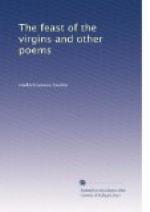To Daniel Greysolon DuLuth, and not to Father Hennepin, whom he rescued from his captors at Mille Lacs, belongs the credit of the first exploration of Minnesota by white men.
Father Hennepin was a self-conceited and self-convicted liar. Daniel Greysolon DuLuth “was an honest man.”
NOTES TO THE SEA-GULL
[1] Kay-oshk is the Ojibway name for the sea-gull.
[2] Gitchee—great,—Gumee—sea or lake,—Lake Superior; also often called Ochipwe Gitchee Gumee, Great lake (or sea) of the Ojibways.
[3] Ne-me-Shomis—my grandfather. “In the days of my grandfather” is the Ojibway’s preface to all his traditions and legends.
[4] Waub—white—O-jeeg—fisher, (a furred animal). White Fisher was the name of a noted Ojibway chief who lived on the south shore of Lake Superior many years ago. Schoolcraft married one of his descendants.
[5] Ma-kwa or mush-kwa—the bear.
[6] The Te-ke-nah-gun is a board upon one side of which a sort of basket is fastened or woven with thongs of skin or strips of cloth. In this the babe is placed and the mother carries it on her back. In the wigwam the tekenagun is often suspended by a cord to the lodge-poles and the mother swings her babe in it.
[7] Wabose (or Wabos)-the rabbit. Penay, the pheasant. At certain seasons the pheasant drums with his wings.
[8] Kaug, the porcupine. Kenew, the war-eagle.
[9] Ka-be-bon-ik-ka is the god of storms, thunder, lightning, etc. His home is on Thunder-Cap at Thunder-Bay, Lake Superior. By his magic the giant that lies on the mountain was turned to stone. He always sends warnings before he finally sends the severe cold of winter, in order to give all creatures time to prepare for it.
[10] Kewaydin or Kewaytin, is the North wind or North-west wind.
[11] Algonkin is the general name applied to all tribes that speak the Ojibway language or dialects of it.
[12] This is the favorite “love-broth” of the Ojibway squaws. The warrior who drinks it immediately falls desperately in love with the woman who gives it to him. Various tricks are devised to conceal the nature of the “medicine” and to induce the warrior to drink it; but when it is mixed with a liberal quantity of “fire-water” it is considered irresistible.
[13] Translation:
Woe-is-me! Woe-is-me!
Great Spirit, behold me!
Look, Father; have pity upon me!
Woe-is-me! Woe-is-me!
[14] Snow-storms from the North-west.
[15] The Ojibways, like the Dakotas, call the Via Lactea (Milky Way) the Pathway of the Spirits.
[16] Shinge-bis, the diver, is the only water-fowl that remains about Lake Superior all winter.




